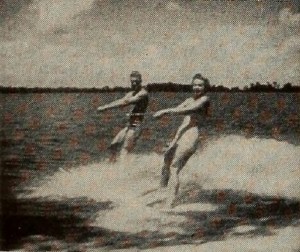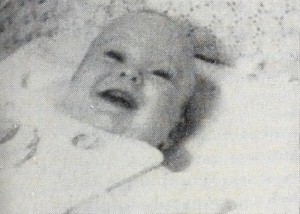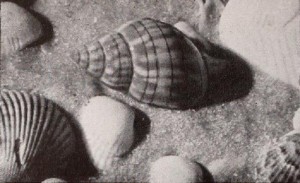"By Sea To Florida, 400 ft., 16mm., made by Porter Varney of Bradenton, Fla., is a film record of a sea trip which derives its importance from the fact that the photography and choice of viewpoint are consistently exceptional. Parts of the ship, such as the rigging and cordage, the portholes, the lifeboat davits, etc., were used with rare artistry as aids to composition and effect. An expert use of filters produced exceptionally pleasing and truthful black and white rendition of the sea and the movement and sway of the ship. Continuity was effectually obtained by a shifting of the camera viewpoint, emphasizing the harbor, the high seas and the arrival in Florida. A startling climax to the film was given by a series of shots of an approaching hurricane captured by Mr. Varney 's intrepid camera." Movie Makers, Dec. 1931, 685.

"Anyone who sees Fabulous Florida will appreciate that Haven Trecker not only has covered that state thoroughly in his travels, but that he has worked hard to record its tourist and industrial highlights in a long series of effective sequences. Beautifully photographed, well edited and with a pleasantly informative narrative, Fabulous Florida is distinguished by the excellence of many of its sequences. We remember with particular pleasure the section devoted to Marineland and its sea life, and the colorful sequence on the manufacture of fishing lures." Movie Makers, Dec. 1953, 334.
"Florida, a documentary film of that state, made in Kodacolor by H. W. Voss, ACL, has been given Honorable Mention because of the freshness and charm of its component subject matter. Replete with human interest material, such as sequences of wild turkeys, new born calves and clumsy, appealing puppies, the picture is a bright and amazing mine of simple entertainment. Though Mr. Voss slips occasionally from a uniformly high technical standard of color work, he need bow to no one in the warmth and charm which he finds and records everywhere in the life about him." Movie Maker, Dec. 1934, 546.
"Choosing one of the most common sites of seasonal move making, Benjamin Crocker has by the sheer virtuosity of his production methods come up with an attractive and entertaining travel short. Here are, to be sure, Marineland, Miami, Silver Springs, Cypress Gardens and all the rest, tied neatly together with an animated map and a lively commentary. But with his clean camera work, fresh viewpoints and incisive editing, Mr. Crocker covers them in a tight ten minutes of unflagging good fun. To these same subject other amateurs have devoted twenty, forty or even-sixty minutes, and, all too often, have encountered the inevitable law of diminishing returns, Florida Vacation Fun dances where others have dawdled" PSA Journal, Jan. 1955, 48.

"Louis Dishotsky and Arthur Rosenthal have put together in High Card Goes an entertaining variation on the travel record film. A definite story line replaces the usual slight continuity device. A pair of tickets for a Florida trip are won on a radio quiz show, but since both parents and two children cannot go, the mother and the father draw cards, high card winning. Wifey tops her mate's king with an ace and takes off for Florida, with the older child. The luckless husband is left to tend the baby and the house. While the acting is fine and the production is technically competent, the pictorial-dramatic pace is rather slow. Tighter editing is indicated." Movie Makers, Dec. 1951, 411-412.
"George Merz offers a masterful job of photography in his travel film, 'In The Sky Over Miami'." American Cinematographer, May 1952, 224.

"You may have wandered idly along the seashore and picked up an attractive seashell, but, unless you are a conchologist, you will never know how far an interest in shells will carry you, until you have seen Jewels of the Sea, by W. W. Vincent, jr. This film is a story of collecting seashells. It tells, with freshness and enthusiasm, how shells are discovered on the shore, how they are cleaned and prepared for preservation and how they are studied. On the west coast of Florida, we see hunters searching for specimens ; we visit a shell shop and the home of a collector. The camera, plus color film, reveals the beauty of the specimens and presents intriguing mysteries, for some of the shells were built by mollusks that have never been seen alive. The source of their irridescent beauty is entirely unknown. Jewels of the Sea does not pretend to be an educational film about zoology, but it is informative as well as entertaining, and it is distinguished by flawless camera work." Movie Makers, Dec. 1943, 457, 474.
"Our Friendly Enemies: This unique title has its origin in the fact that the Seminoles are the only native American Indians who have never signed a peace treaty with the government. Ralph E. Gray has chronicled in color with his 16mm Cine Special camera the contemporary life of the Seminoles living in Florida, picturing their activities against the backdrop of modern-day living and habits. Gray's reputation for camera and good editing has resulted in very professional results on the screen. Narration and sound effects on the recorded track round out the superior treatment of this better than average amateur effort." American Cinematographer, May 1951, 190.
Total Pages: 2